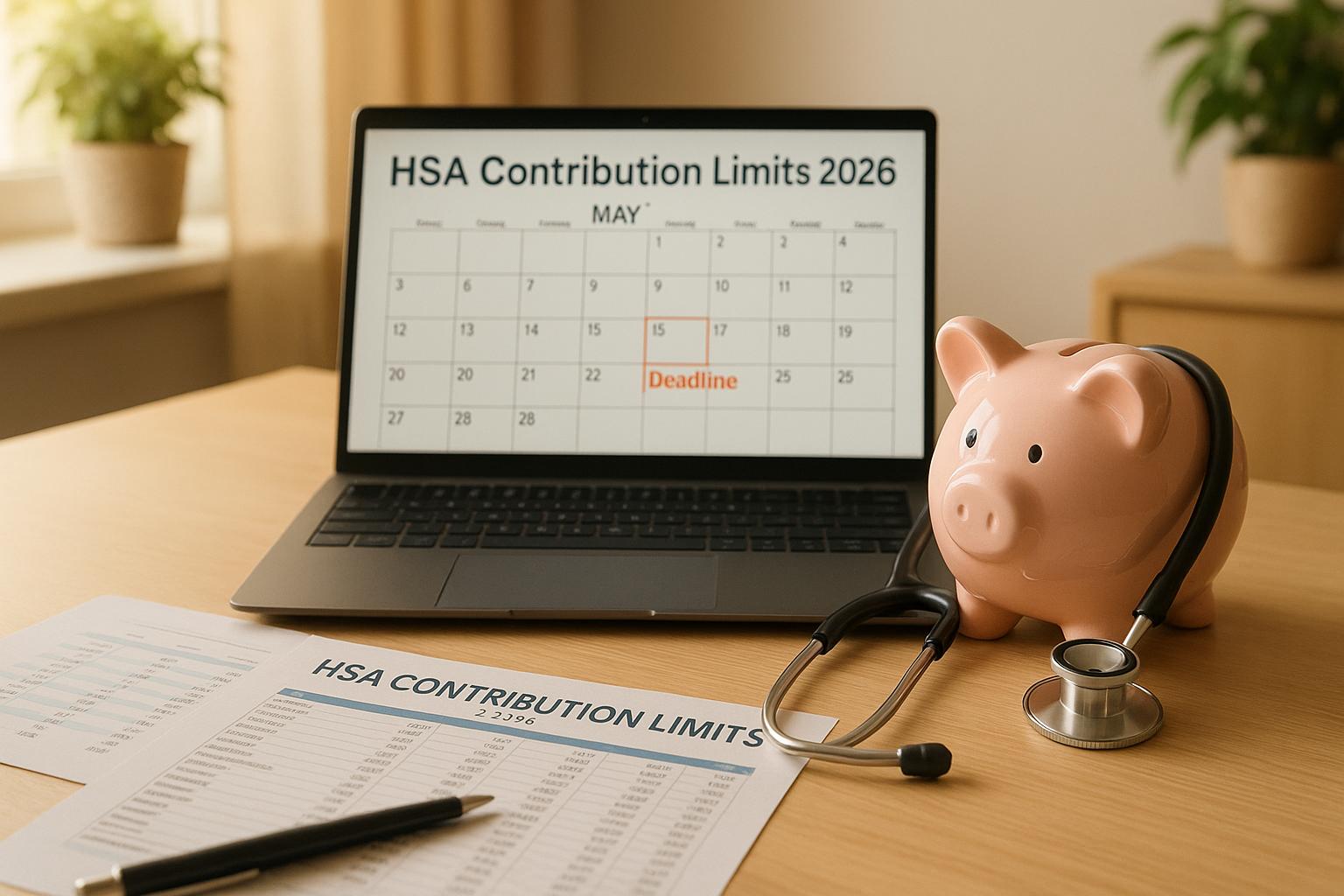HSA Contribution Limits for 2026:
- Individual Coverage: $4,150
- Family Coverage: $8,300
- Catch-up Contribution (55+): $1,000
Key Deadlines:
- You can contribute to your HSA for 2026 until April 15, 2027.
HDHP Requirements for HSA Eligibility:
- Minimum Deductibles: $1,600 (Individual), $3,200 (Family)
- Maximum Out-of-pocket: $7,750 (Individual), $15,500 (Family)
HSAs offer tax-deductible contributions, tax-free growth, and tax-free withdrawals for medical expenses. Unused funds roll over yearly, making HSAs a great long-term savings tool. Plan your contributions early to maximize tax benefits and savings.
What Are the HSA Contribution Rules in 2025?
2026 HSA Contribution Limits
The IRS has announced updated HSA contribution limits for 2026, reflecting inflation adjustments. These changes allow for greater tax-advantaged healthcare savings.
Single and Family Coverage Limits
Here are the updated HSA contribution limits for 2026:
| Coverage Type | 2026 Contribution Limit |
|---|---|
| Individual Coverage | $4,150 |
| Family Coverage | $8,300 |
| Catch-up Contribution (age 55+) | $1,000 |
The catch-up contribution remains $1,000, as this amount is fixed by law and doesn’t change with inflation. If you turn 55 or older during 2026, you can make this additional contribution on top of your regular limit.
These limits are essential to understand if you’re planning to meet the HDHP (High Deductible Health Plan) requirements outlined below.
HDHP Rules and Requirements
To qualify for HSA contributions in 2026, your health plan must meet the IRS’s definition of a High Deductible Health Plan (HDHP). Here are the requirements:
| HDHP Requirements | Individual Coverage | Family Coverage |
|---|---|---|
| Minimum Deductible | $1,600 | $3,200 |
| Maximum Out-of-pocket | $7,750 | $15,500 |
Your plan must meet the minimum deductible and keep out-of-pocket costs within the stated limits.
Key Compliance Points:
- Contributions are calculated monthly but count toward the annual limit.
- If you become HSA-eligible partway through the year, your contribution is prorated.
- Employer contributions are included in your annual limit.
- Any excess contributions must be withdrawn by the tax filing deadline to avoid penalties.
HSA-qualified plans typically cover preventive care before the deductible is met, but you’ll need to meet the deductible for non-preventive services.
Key HSA Dates for 2026
Contribution Deadlines
For the 2026 tax year, you can make HSA contributions until April 15, 2027. This gives you extra time to plan your taxes and maximize your savings.
Here’s how the contribution timeline breaks down:
| Contribution Period | Deadline | Notes |
|---|---|---|
| Regular 2026 Contributions | January 1 – December 31, 2026 | Payroll contributions reduce FICA taxes by 7.65%. |
| Extended Contributions | January 1 – April 15, 2027 | Contributions still count toward 2026 limits. |
| Tax Extension Impact | April 15, 2027 | Even with a tax extension, contributions must be made by this date. |
If you enroll mid-year, contributions are prorated. For example, starting family coverage on July 1 means you can contribute roughly half of the annual limit.
Submitting Expenses
You can submit HSA expenses anytime after they occur, as long as your HSA was active when the expense was incurred. To ensure smooth reimbursement, keep detailed records, including:
- Receipts with dates of service
- Provider information
- Proof of payment
- Documentation for any non-standard expenses
Any unused funds in your account roll over automatically – there’s no "use it or lose it" rule. Contributing early in the year also allows for more tax-free growth over time.
sbb-itb-a729c26
How to Get the Most from Your HSA
Using HSAs with Other Accounts
Many employers provide access to both a Health Savings Account (HSA) and a Limited Purpose Flexible Spending Account (LPFSA). While an LPFSA is specifically for dental and vision expenses, your HSA covers a wider range of eligible medical costs. Combining these accounts can help you make the most of your tax advantages and better manage healthcare spending. This strategy allows for smarter planning when it comes to contributions and expenses.
Local HSA Support Services
Managing HSA requirements and making the most of them can be tricky without the right guidance. Illinois Health Agents offers expert assistance to individuals and businesses across Illinois, ensuring you get the most out of your HSA.
Tailored HSA Guidance for Illinois Residents
Illinois Health Agents specializes in helping residents of the state fine-tune their HSA strategies. Their licensed agents can assist with:
- Tracking contributions and creating tax-efficient strategies
- Educating employees on HSA benefits and how to maximize contributions
For businesses, they provide clear, structured support with straightforward pricing:
- Free services for companies with more than 10 employees
- $250 annual fee for smaller businesses (10 or fewer employees)
To complement this guidance, they also help you choose HDHPs that align with HSA requirements.
Assistance with HDHP Selection
Picking the right High Deductible Health Plan (HDHP) is key to HSA eligibility. Illinois Health Agents simplifies this process by:
- Reviewing plans from highly rated carriers (A.M. Best Rating of A- or better)
- Confirming that plans meet HSA-qualifying HDHP standards
- Suggesting options based on your healthcare needs and budget
- Integrating new plans with your current insurance coverage
With licensed agents operating in 46 states, they also offer ongoing support, including annual reviews and updates on regulatory changes that may impact your HSA.
Summary
Health Savings Accounts (HSAs) are a smart way to manage healthcare costs and save for the future in 2026. To make the most of your HSA, it’s essential to understand contribution limits, stay on top of deadlines, and use strategies that maximize its benefits.
Licensed agents can provide expert advice to help you make informed decisions about your HSA and High Deductible Health Plan (HDHP). Illinois Health Agents offers personalized support to guide you through these choices. Planning your contributions and healthcare expenses early ensures you get the most out of these benefits.
"We have no allegiance to any one insurance company. We just want what’s best for you!" – Illinois Health Agents
Here’s what success with HSAs looks like:
- Knowing contribution limits and consistently making deposits throughout the year.
- Choosing the right HDHP that matches your healthcare needs while keeping HSA eligibility intact.
- Taking advantage of tax benefits by timing contributions wisely and exploring investment options.
By aligning your HSA contributions with HDHP requirements, you can achieve both immediate savings and long-term financial growth. Local experts can help you make the most of these benefits with regular education sessions, contribution planning, and annual reviews.
With the right planning, your HSA becomes a powerful tool to cover future healthcare needs.
FAQs
What are the advantages of contributing to an HSA early in the year, and how does it help grow your savings tax-free?
Contributing to your Health Savings Account (HSA) early in the year offers several key benefits. By funding your HSA sooner, you allow more time for your contributions to grow tax-free through interest or investment earnings. The earlier your money is in the account, the more time it has to benefit from compound growth, maximizing your savings over time.
Additionally, early contributions ensure you have funds available for qualified medical expenses throughout the year, avoiding potential out-of-pocket costs. Keep in mind that HSA contributions are tax-deductible, so contributing sooner can also help you better plan your annual tax strategy.
What makes a health plan eligible as a High Deductible Health Plan (HDHP) for HSA contributions?
To qualify as a High Deductible Health Plan (HDHP) for Health Savings Account (HSA) contributions, your health plan must meet specific requirements set by the IRS. For 2026, the plan must have a minimum deductible of $1,600 for individual coverage or $3,200 for family coverage. Additionally, the plan’s out-of-pocket maximum cannot exceed $8,050 for individuals or $16,100 for families.
It’s also important to ensure that your plan doesn’t provide coverage for any services (except preventive care) before meeting the deductible. If you’re unsure whether your plan qualifies, check with your insurance provider or consult a trusted health insurance expert like Illinois Health Agents for personalized guidance.
What should I do if I contribute more than the annual HSA limit, and how can I avoid penalties?
If you accidentally contribute more than the annual HSA limit, it’s important to act quickly to avoid penalties. You can withdraw the excess contributions and any earnings on them before the tax filing deadline (typically April 15) for the year the contributions were made. This will help you avoid the 6% excise tax that applies to excess contributions.
To prevent over-contributing in the future, keep track of your HSA contributions throughout the year and ensure they stay within the IRS limits. If you’re unsure about the limits or need assistance, consult a tax professional or your HSA provider for guidance.



0 Comments